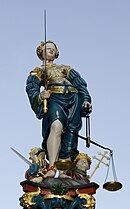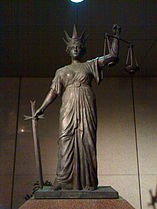- Back to Home »
- Lady Justice - Nữ thần công lý
Posted by : Unknown
Chủ Nhật, 12 tháng 10, 2014

From Wikipedia, the free encyclopedia
"Justitia" redirects here. For the crustacean genus, see Justitia (genus).
"Lady Justice" and "Lord Justice" are also titles for judges on the Court of Appeal of England and Wales.
Lady Justice (Latin: Iustitia,[1] the Roman goddess of Justice, who is equivalent to the Greek goddesses Themis and Dike) is an allegoricalpersonification of the moral force in judicial systems.[2][3]
Depiction
The personification of justice balancing the scales dates back to the Goddess Maat, and later Isis, of ancient Egypt. The Hellenic deities Themisand Dike were later goddesses of justice. Themis was the embodiment of divine order, law, and custom, in her aspect as the personification of the divine rightness of law. However, a more direct connection is to Themis' daughter Dike, who was portrayed carrying scales.
"If some god had been holding level the balance of Dike" is a surviving fragment of Bacchylides' poetry. Ancient Rome adopted the image of a female goddess of justice, which it called Iustitia.[4] Since Roman times, Iustitia has frequently been depicted carrying scales and a sword, and wearing a blindfold. Her modern iconography frequently adorns courthouses and courtrooms, and conflates the attributes of several goddesses who embodied Right Rule for Greeks and Romans, blending Roman blindfolded Fortuna (fate) with Hellenistic Greek Tyche (luck), and sword-carrying Nemesis (vengeance).
Lady Justice is most often depicted with a set of scales typically suspended from her right hand, upon which she measures the strengths of a case's support and opposition.[citation needed] She is also often seen carrying a double-edged sword in her left hand, symbolizing the power of Reason and Justice, which may be wielded either for or against any party.[citation needed]
Blindfold
Since the 15th century, Lady Justice has often been depicted wearing a blindfold. The blindfold represents objectivity, in that justice is or should be meted out objectively, without fear or favour, regardless of identity, personal wealth, power, or weakness; blind justice and impartiality. The earliest Roman coins depicted Justitia with the sword in one hand and the scale in the other, but with her eyes uncovered.[5] Justitia was only commonly represented as "blind" since about the end of the 15th century. The first known representation of blind Justice is Hans Gieng's 1543 statue on the Gerechtigkeitsbrunnen (Fountain of Justice) in Berne.[6]
Instead of using the Janus approach, many sculptures simply leave out the blindfold altogether. For example, atop the Old Bailey courthouse in London, a statue of Lady Justice stands without a blindfold;[7] the courthouse brochures explain that this is because Lady Justice was originally not blindfolded, and because her “maidenly form” is supposed to guarantee her impartiality which renders the blindfold redundant.[8] Another variation is to depict a blindfolded Lady Justice as a human scale, weighing competing claims in each hand. An example of this can be seen at the Shelby County Courthouse in Memphis, Tennessee.[9]
The cover of a 2006 issue of Rolling Stone proclaimed TIME TO GO!, focusing on the perceived corruption that dominated Congress. The drawing showed a bunch of figures evoking reactionary politics emerging from the Capitol Building. One of the figures was Lady Justice lifting her blindfold, implying that the then-composition of Congress had politicized the criminal justice system.
Justice in sculpture
|

















